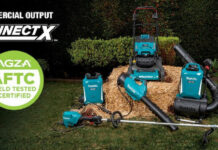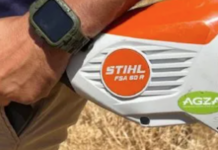One of Turf’s first reports on The American Green Zone Alliance (AGZA) was back in 2014 when Jamie Banks, Executive Director of Quiet Communities Inc., wrote about meeting Dan Mabe, AGZA President and Founder, in April 2013 and deciding to collaborate. Banks wrote, “I thought then we could be on the verge of an electric revolution in landscape maintenance.” Later in the article, she added, “The era of electric landscape maintenance is in its infancy. It has a long way to go before it becomes mainstream.” At the time, Banks predicted slow adoption of the technology, starting with schools, hospitals, luxury properties, parks, and municipalities. Seven years later, she hasn’t been wrong.
Mabe describes AGZA as “a group of people whose mission is to ‘prudently’ help facilitate low impact, cleaner, and quieter technologies and operations for the grounds maintenance industry.” Despite the inertia of change in any industry, the movement is steadily growing as electric and battery technology improves, product costs come down, and environmental awareness increases among clients and providers. Today, AGZA represents an alliance of communities, advocacy groups, service providers, manufacturers, and more who are leading the landscaping industry toward what they see as the inevitable future.

Interestingly, during the peak of the COVID-19 pandemic, AGZA experienced a surge of community interest as kids and parents were schooling and working from their homes. “We were overwhelmed with inquiries because people now started to realize the elevated noise levels from gas powered service on their own properties, which are a distraction to learning and working in home environments,” said Mabe.
Now, in 2021, AGZA has a series of national initiatives to promote the transition to “cleaner” landscaping equipment and practices. Most are extended through AGZA’s aforementioned partner, the national non-profit Quiet Communities Inc. The three core services with the most participation include:
- AGZA Green Zone Certification. Designation of an area that has committed to more environmentally friendly solutions in lawn maintenance.
- AGZA Service Pro Certification. Online workforce training and education courses in English and Spanish, as well as live webinar workshops, on operating and using low noise, zero-emission, low-emission equipment and sustainable practices.
- ELF™ (Environmental Landscape Footprint) Reports. ELF reports collect data and measure impact reductions for Green Zone projects or can give any outdoor power operations a look at what environmental impacts occur with the maintenance of their properties.
Certified Green Zones
An AGZA Certified Green Zone is a dedicated property, or collection of properties, which have agreed to conduct grounds maintenance operations with low noise and low impact equipment and operations. AGZA independently verifies each project to ensure its sustainability standards. The minimal requirements for an AGZA Certified Green Zone are the complete elimination of two-stroke equipment use for routine maintenance tasks. However, most Green Zones have opted for a higher standard—phasing out all gas operations for routine maintenance and employing best practices where workload feasible. Currently, there are 15 Certified Green Zones (in four states including California, Illinois, Alabama, and New York) as well as seven others that are in phase one development.
“I have worked at the Arroyo Seco Golf Course for 48 years and used only gas equipment until I was introduced to AGZA,” comments John De La Torre, ground’s supervisor of Arroyo Seco Golf Course in South Pasadena, CA, the first AGZA Green Zone golf course in the U.S. He continues, “The AGZA Green Zone Certification process helped us navigate the transition to electric operations with a prudent process where we tried tools before we purchased them, set up charging infrastructure, and helped with our return-on-investment timetable. Our golf course has phased out all two-stroke equipment and uses an electric greens mower for all 18 greens and the practice putting area. We have had this certification for over four years and save 960 gallons of gas per year.”
A more recent introduction to the Certified Green Zone Initiative is a focus on individual residences through the AGZA Residential Green Zone Initiative (ARGZI). ARGZI encourages a property owner to take a more sustainable approach to lawn and garden activities by NOT: using gas powered equipment; planting non-natives; having excessive amounts of turf; using inefficient or wasteful water practices; or using hazardous fertilizer, pesticide, or herbicide chemicals.
AGZA Service Pro Certification
The AGZA Service Pro Certification helps landscape crews to be proficient in battery and electric technology, operation, maintenance, and safety practices. Since the transition from gas equipment is full of challenges, AGZA educates, trains, and certifies management and crews to help avoid the predictable pitfalls. A free preview of the 15-lesson course is available on the AGZA site.
Currently, there are 26 AGZA Certified Service Pros across the U.S., including five new companies just announced this past March. One of the Certified firms is Orlando-based Suntek Florida. Brian Curtis Crisp, a Suntek employee who previously worked for a company that exclusively used gas-powered equipment, says he has witnessed firsthand the change in customer attitudes that accompanies the switch to battery and electric. “I’m no longer seen as the annoying guy coming to terrorize neighborhoods,” he comments. “Instead, customers actually randomly stop by to say ‘hi!’” Another Suntek employee, Anthony Adorno, also once worked for a company with gas-powered equipment. He points out that the transition has actually helped his own health. “I can receive hugs and kisses from my family instantly upon approaching the door because there’s no oil and gas on me,” he comments.
Evolution Of Equipment
While electric equipment may offer environmental and health benefits, many feel the technology still needs to “catch up” to be as powerful, effective, and cost efficient as gas; and only then will it truly receive widespread adaptation. With over a decade of transitioning grounds operations from gas to electric, AGZA has collected raw data on workload production and cost differences. “We know for certain that many battery electric tools are now apples for apples in work production rate capability with their gas counterparts,” says Mabe. “For example, string trimmers are achieving gas powered work production rates for routine maintenance using 0.095-to-0.105-gauge line for several different models on the market. Chainsaws performing light to medium duty workloads will perform just as well as any typical gas-powered top handle, rear handle, and pole saw.”

Lawn mowers have also come a long way in a short amount of time. “With the exception of a few unique cutting conditions in peak growing seasons, battery electric mowers are keeping up with their gas competitors, with mowers ranging from 21″ walk behinds to 74″ riding mowers,” says Mabe.
The increasing acceptance and use of robotic mowers is opening up yet other options. Last August, Turf reported on an AGZA Green Zone in Woodstock, IL where Langton Group—a full-service, 250-employee, landscape construction, maintenance, and snow removal company—is converting its commercial customer base to automatic daily mowing using Husqvarna Automower®. With the help of Automated Outdoor Solutions, also owned by Joe Langton, Langton Group is setting up eco-contracts to perform property maintenance with battery equipment and creating off-grid charging for the Automowers®.
The Cost Consideration
Unfortunately, the electric platforms are more expensive initially and, in some cases, require training to help realize their ROI. As a result, AGZA currently collaborates with multiple air districts and municipalities to help with outreach, education, and cost savings. Some entities, such as the San Joaquin Air Pollution Control District, Antelope Valley Air Quality Management District, Imperial County Air Pollution Control District, and Santa Barbara County Air Pollution Control District, address the obstacle of initial cost by offering financial incentives to those who trade in gas tools.
The South Coast Air Quality Management District (SCAQMD) in California, has a Commercial Electric Lawn & Garden Equipment Incentive & Exchange Program where landscapers who turn in one operable gasoline- or diesel-powered piece of equipment qualify for incentive funding (up to 75%) towards a battery electric replacement. Participants in the program can select from a variety of commercial-grade electric equipment, including: handheld trimmers; chainsaws; pruners; backpack and handheld blowers; and ride-on, stand-on, walk-behind, and robotic lawn mowers. Manufacturers including Husqvarna, Makita, Mean Green, OREGON, and STIHL have dealership locations that participate in the program. For more information, visit aqmd.gov/lawnmower.
AGZA also engages with manufacturers and dealers who understand the importance of education in easing the transition to new equipment. Yet besides training, AGZA also encourages these companies to offer incentives—separate of governmental agency programs—on battery platforms when possible. AGZA’s current certified manufacturers include: STIHL, Husqvarna, OREGON, EGO, and Mean Green. “If crews are properly trained and take care of the equipment, they will get a return on their investment,” asserts Mabe.
The Future
AGZA predicts a lower impact future for the landscape maintenance industry by reducing internal combustion operations and implementing battery- and people-powered maintenance in communities. The results of these changes are: healthier working conditions for the lawn and garden workforce; cleaner air; and quieter maintenance in neighborhoods. That said, AGZA cautions there are possible down sides to shifting the grounds maintenance industry exclusively to battery technologies irresponsibly. Shortages in components and raw materials needed to keep up with demand for lithium batteries are already being experienced. Additionally, safe and adequate charging infrastructure will be necessary to allow for the continual growth and successful transitions to battery operations. “Our industry is heading into unknown territory,” comments Mabe. “We need to do this prudently and responsibly and recognize the need for proper recovery, re-purposing, and recycling of lithium batteries and e-waste.”
 Mabe created the AGZA Green Zone Certification program to further the acceptance of cleaner battery powered technologies specific to the grounds maintenance industry. AGZA Certification ensures lower emissions, noise, and land waste impacts by reducing the use of internal combustion technology to maintain properties. Mabe and his team work with cities, towns, academia, landscape maintenance companies, contractors, and air quality management agencies providing sustainable grounds maintenance education and consultation. For more information, visit agza.net.
Mabe created the AGZA Green Zone Certification program to further the acceptance of cleaner battery powered technologies specific to the grounds maintenance industry. AGZA Certification ensures lower emissions, noise, and land waste impacts by reducing the use of internal combustion technology to maintain properties. Mabe and his team work with cities, towns, academia, landscape maintenance companies, contractors, and air quality management agencies providing sustainable grounds maintenance education and consultation. For more information, visit agza.net.
Menapace is managing editor of Turf.











![[VIDEO] Dickies®: Discover Workwear That’s Anything But Uniform](https://turfmagazine.com/wp-content/uploads/2023/06/1647663814-4b1a2a7742790a9b1e97a3b963477850192e1d6a9dfba9b07214a77bae25d6e3-d-218x150.jpg)



























![[VIDEO] Dickies®: Discover Workwear That’s Anything But Uniform](https://turfmagazine.com/wp-content/uploads/2023/06/1647663814-4b1a2a7742790a9b1e97a3b963477850192e1d6a9dfba9b07214a77bae25d6e3-d-324x160.jpg)